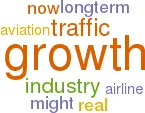Have airlines slowed down permanently?
March 2003


Just about everyone in the mainstream aviation industry — from the manufacturing, financing, airport and airline sectors — has relied on a perceived long–term relationship between GDP growth and traffic (RPK growth) of 2.5:1. Consequently, long–term traffic forecasts almost always show global traffic growth of around 5–6% pa with suitable regional variations.
Now this consensus is being challenged. For instance, Andrew Sentance, Chief Economist at British Airways, speaking at the recent Geneva Aviation Finance Conference, commented that not only would there be no immediate traffic bounce–back, but also the industry might expect a significantly lower long–term growth rate.
He noted that real airline yield has halved since 1970, so to some extent growth has been "bought". There is now a major question as to whether industry can grow at forecast RPK rates of 5–6% pa as it is running out of the ability to decrease costs.
"Financially sustainable growth" is perhaps more realistic at 3- 4% pa, assuming a 1–2% decrease in real yields. This growth rate would also be closer to the concept of "environmentally sustainable growth" of 2–3% pa. Lobbying from various environmental bodies is now focusing on capping air traffic growth through new taxes on fuel burn, emissions, noise, etc. Now might be a good time for the airline business to prove its green credentials by setting growth limits in cooperation with the environmental lobby.
The economic reasons behind the projected slow–down in long term growth are fairly evident:
- The US industry is experiencing an unprecedented shock with real revenue declines of 25% in domestic market, two to three times worse than ever experienced before;
- The uncertain global economic outlook;
- Security concerns and related travel inconvenience becoming an on–going feature of air travel;
- Unfriendly policy environment (antitrust regulation preventing consolidation, restrictive bilaterals and environmentalism)
- Some markets appear to have reached maturity, notably the US where real revenue growth has been lower than GDP growth throughout the 1980s and 1990s.
A couple of countervailing arguments:
- The US network carrier industry is going through an unprecedented period of restructuring — a subject which dominates this issue of Aviation Strategy, see American and United (pages 2–7) and Continental (pages 8–12) — and it might be premature to draw any long term conclusion on traffic trends from the current crisis;
- While a slow–down in long–term growth might be inevitable for the network or long–haul carriers, the opposite prospect faces the low cost, short–haul carriers.